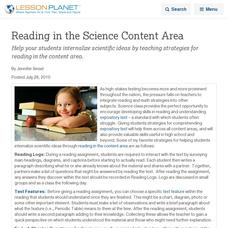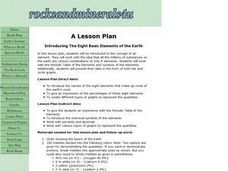Virginia Department of Education
Properties of Compounds and Chemical Formulas
Young chemists have unknown compounds they need to sort. Performing three different tests on each, the chemical behaviors they observe become the basis for data analysis.
Virginia Department of Education
Matter and Energy: Equations and Formulas
Using simple materials, an informative lesson demonstrates the Law of Conservation of Matter and explains how to balance chemical equations. Young chemists perform experiments, analyze reactions, and balance chemical equations on their...
Curated OER
Science Puzzle
In this science worksheet, students identify and locate vocabulary words related to various sciences. There are 20 words located in the word search.
Curated OER
Fighting Corrosion to Save an Ancient Greek Bronze
Study corrosion on bronze statues with a hands-on lesson plan. As pupils place a penny in water with salt, they observe the changes in the penny throughout a period of a week. They then analyze the pre-conservation and the...
Curated OER
Elements
In this elements worksheet, students write the electron configurations for given elements. Students describe ionization energy and electron affinity and the periodic trends for both. This worksheet has 20 short answer questions.
Curated OER
Compound Exercise
In this chemistry worksheet, students name each of the listed compounds on the sheet. Then they compare each of the compounds to those of the periodic table.
Curated OER
General Chemistry I
For this chemistry worksheet, students balance each of the reactions presented using the periodic table to help. Then they predict the products of the reactions and write the net ionic equation. Students also write the empirical formulas...
Curated OER
Chemical Families Quiz
In this chemical families activity, learners answer 8 multiple choice questions including identifying characteristics of families in the periodic table and answering specifics about each family.
Curated OER
Properties of the Elements
In this elements worksheet, students compare the properties of elements in the periodic table such as their atomic radii, valence electrons and ionization energy.
Curated OER
The Structure of the Elements
In this chemistry worksheet, students study the composition of the elements in the periodic table using an interactive website.
Curated OER
Naturally Magnetic Elements
Students explore naturally magnetic elements. For this magnets lesson, students examine the periodic table of elements. Students discover the parts of an atom and determine which three elements are magnetic.
Curated OER
Transition Metals
In this transition metals worksheet, students fill in a table given a metal compound with the charges of the anion and cation. They then determine the name of the compounds.
Curated OER
Elements Compounds and Mixtures
In this science worksheet, students apply science basic knowledge of chemistry to the puzzles that are listed for the four parts of the sheet while focusing upon the identification of a metalloid.
Curated OER
Calculating the Average Mass of the Newly Discovered Element: Bean
Students determine the average mass of a new element using masses from three isotopes. In this chemistry instructional activity, students explain what an isotope is. They discuss their importance and uses.
Curated OER
CEENBot Soccer
Students research the history and uses of the different elements in the periodic table. In this chemistry lesson, students explain the significance of an element's valence electrons. They create a multimedia presentation of an element...
Virginia Department of Education
Elements and Electron Configuration
It's electronic! Pupils uncover elements and their electron configurations as they explore mass, groupings, correct charges, and sliding theory. Young scientists learn creative ways to remember various elements and correctly classify...
Virginia Department of Education
Molar Volume of a Gas
What is a chemist's favorite plant? Stoichiome Tree! Scholars produce hydrogen gas by reacting magnesium with hydrochloric acid. Then they calculate the molar volume of the gas produced before answering assessment questions.
Virginia Department of Education
Solution Concentrations
What happens when you combine 6.022 times 10 to the 23 piles of dirt into one? You make a mountain out of a mole hill. Scholars use dehydration to obtain percent composition and then calculate the molarity of the original solution.
Virginia Department of Education
Radioactive Decay and Half-Life
Explain the importance of radioactive half-life as your high school biologists demonstrate the concept by performing a series of steps designed to simulate radioactive decay. Pupils use pennies to perform an experiment and gather data....
Virginia Department of Education
Chemical Bonds
How are chemical bonds similar and how are they different? Provide your young chemists with the resources to more thoroughly understand the concepts of ionic and covalent bonds. Pupils research these topics, diagram examples of each...
Curated OER
Reading in the Science Content Area
Help your students internalize scientific ideas by teaching strategies for reading in the content area.
Curated OER
Who Dirtied The Water/Clean Water: Is It Drinkable?
Students enter the room, receive a film canister that contains materials that be added to the dirty water bell jar. They record on their data table who or what is doing the adding and the actual substance that has been added to the bell...
Curated OER
1999 U.S. National Chemistry Olympiad Part III
In this chemistry olympiad laboratory worksheet, learners design and carry out two experiments. They design one experiment to test for the percent mass of a substance in a solution and they design another experiment to identify two...
Curated OER
Eight Basic Elements of the Earth
Students identify the concept of an element and work with an idea that all of the millions of substances on the earth are various combinations of only 8 elements. They work with the Periodic Table of the Elements and symbols of the...

























